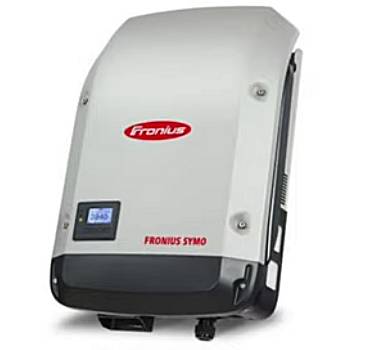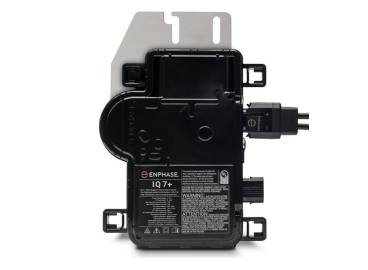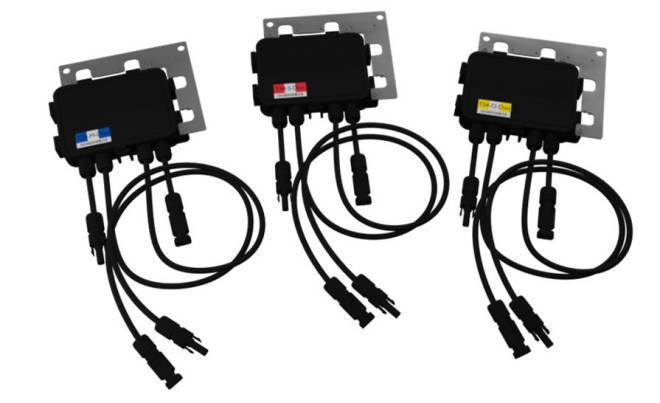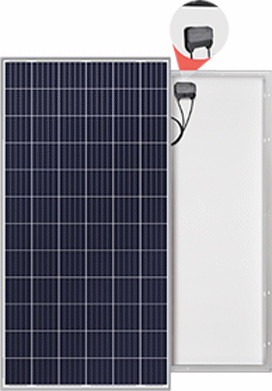Solar string inverters, micro-inverters and power optimizers. What’s the best choice? Finn offers his point of view in this video (transcript included).
Transcript begins :-
There are three main components in a solar PV system – the panels, the racking/mounting, and the inverter. This video focuses on the inverter, whose job it is to convert the DC electricity generated by the panels into AC electricity that is used by your home.
Inverter Choices
Now, you’ve got three choices when it comes to inverters.
- String inverters
- micro-inverters
- and optimiser based systems; which are kind of a hybrid between string and microinverter technology.
If you’ve got a short attention span, here’s my hot take. Microinverters and optimizer based systems are more expensive than simple string inverters, but they have a variety of benefits that make them worth considering; especially if you have a shaded roof.
Now, let’s go into details.
String Inverters
String inverters are roughly the size of a briefcase and they are mounted on a wall. All of the panels connect into them. For residential sized systems, you’ll only need one string inverter per solar system. They operate at high DC voltages, but they’re perfectly safe when installed by a competent licensed solar electrician.

String inverter – 1 per solar system
Microinverters
Microinverters on the other hand are the size of small paperback books and they’re installed on the back of each individual panel. So, for say a 6.6 kilowatt system made up of 20 panels, you’ll have 20 micro-inverters along with them.
Microinverters convert DC to AC at the source, meaning there’s no high voltage DC running through your roof at any point in time. It’s all much safer AC electricity instead, and this is why I use microinverters for my own home. Parts of my home are made out of straw bales – seriously – and I didn’t like the idea of high voltage DC running through those straw bales.
In Australia in 2020 as far as I’m concerned, the only game in town when it comes to microinverters is Enphase. (Disclosure: Finn holds Enphase shares).

Microinverter – 1 per solar panel
One core advantage of microinverters over string inverters is that it makes every panel independent of each other. So when one panel is shaded, it only affects that panel. In a string system, when one panel is shaded, the whole string of panels can go down – kind of like when you stand on a hose.
Because micro-inverters have this panel level optimization, you’ll also find that you can get as much as 12% more energy out of a microinverter system over a year compared to a string system. This also means that you can have panels facing every possible direction; whereas with string inverters, you can only choose two, sometimes three directions per inverter.
Optimiser-Based Systems
Now let’s talk about optimizer-based systems, which as I said, are sort of a hybrid between string and microinverters.
In a system that uses optimizers, you have both the big string inverter on the wall as well as individual optimizers on each panel. So, you get essentially most of the same benefits as a microinverter based system, but with a slightly different technology.
Now, for many years SolarEdge was the only real optimizer based system on the market. But, there have been two big entrants to the market that have been challenging SolarEdge’s dominance. They are Tigo optimisers and Maxim integrated panels.
Tigo optimisers work with any inverter; whereas with SolarEdge you have to use a SolarEdge string inverter with the SolarEdge optimizers. And, with Tigo, you don’t need to optimize the entire system like you do with SolarEdge. So if only two of your panels are shaded by say an aerial, then you only need to put a Tigo optimiser on those two panels.

Tigo optimisers – 1 per panel where required
That brings significant cost savings compared to SolarEdge, but bringing even more significant cost savings to the market are Maxim integrated panels. At the time of filming, early 2020, the only brand of Maxim integrated panel that is sold in Australia to the best of my knowledge are the Seraphim MX panels.

Seraphim Maxim solar panel
Maxim integrated panels have three tiny chips embedded in the solar panel itself; compared to Tigo or SolarEdge optimisers that are bolted onto the back of the panel. And, these Maxim optimisers bring most of the benefits of other optimisers at a fraction of the cost.
Do You Need Panel Level Optimisation?
Now, do you need this panel level optimization (PLO) at all, or to rephrase, do you need to spend extra money on panel level optimization?
If you have a simple roof with no shading issues, then in my opinion, it’s much harder to justify the extra cost of panel level optimization, but it’s up to you whether it’s worth a few grand. If you have a complicated roof with lots of different faces with or without shading, then PLO is well worth it.
If you have a simple roof with small shading issues, Tigo optimizers will give you the best results for the lowest cost.
Microinverters and Tigo/SolarEdge, but not Maxim, also offer panel level monitoring. Trust me, this gets boring fast, but a small percentage of owners can’t get enough of it – so it may be worth considering being able to monitor the power of each panel individually.
For a deeper dive into panel level optimisation – see this post. For everything you need to know about choosing a solar power system and an installer in Australia, check out Finn’s book, The Good Solar Guide, which is free to read in its entirety online.

 RSS - Posts
RSS - Posts



There was a scientific study performed in 2019 on optimization. In summary, using optimizers on panels that are shaded will provide better performance if moving the affected modules is not possible.
If installing optimizers on panels that aren’t affected by shade, it actually caused a drop in production. This is important for those certain customers who just want them for the sake of it but can’t offer any real explanation as to why.
I must also stress, optimizing modules that are shaded shouldn’t be just optional. Most panel manufacturers won’t warrant panels that have failed due to early diode failure from constant shading. This is very common as the attitude from most installers is ‘They’ll just produce less’. This is half true, they will also likely fail prematurely.
For those interested, the optimization article can be viewed here – https://www.sdu.dk/-/media/files/om_sdu/centre/cie/optimizer+for+pv+modules+ver11_final.pdf
Hi Andrew,
Good points – we covered that study in detail a couple of weeks ago:
https://www.solarquotes.com.au/blog/panel-optimisers-danish-study/
Finn
Hi Andrew/Finn,
I will be half my panels on east facing roof and half on west-facing roof. Would this be considered as “shading” on both sets of panels for half a day ? If so, would optimiser based systems or micro-inverter based systems be useful ? Would my panels suffer from “early diode failure” with either of these systems ?
Regards,
KP
Hi KP, Ronald here.
Your east facing and west facing panels will be on different Multiple Power Point Trackers (MPPT) on your solar inverter. This will allow them to operate independently so they won’t affect each other. Solar installers are not permitted to have panels facing different directions on the same MPPT unless something that will prevent problems is used, such as panel optimisers.
If, instead of a standard string inverter, your installation will use microinverters each panel will operate independently so there won’t be a problem with them.
Re availability of Maxim panels,
one of your recommended installers Solar Wholesalers was supplying and installing Wuxi Suntech STP300S-20/Wfw-Mx Maxim built-in optimiser panels as of November 2019.
I installed 14- 250W panels with micros and Aps monitor in 2014.
Then 2 Enphase Batt’s and 4 LG 330W panels with Enphase Micros and Enlighten Monitor in 2016. The system has worked to predictions so far except proper cycling of the battery charge for a few months after it was installed. The key point about this is that both installers assured me that they would be monitoring the system after it was installed but neither brought it to notice.
The value of the monitoring system to me has been to expose the battery charge problem which proved to be a grid voltage out of limits and with the APs
monitor a good picture of the system performance over the six years of operation.
I am now considering installing a few more panels to take the system to 6 Kw
with Iq7 micros as my ‘chief accountant’ has always hounded me about outage back-up. The maxim panels sound interesting.
What is better micro inverters on your panel or individual optimises on your panel?
Hi Adriana. That will depend on your situation. If your solar system won’t suffer from significant shading then having neither will be a lower cost option. It really comes down to the type of roof you have, shading, and your goals and budget.
hi, I have had a system installed with N,E and W. E and W panels are on the same sting with equal number of panels going into a single phase Fronius Primo 5.0. But after reading this blog I am wondering if I should have TiGO optimisers put on at least on face, say the W panels?
Hi Jeremy
So long as it’s installed correctly a Fronius inverter can successful handle east and west panels on the same string. Unless you have shading issues any improvement from adding optimizers is likely to be minimal and not worth the expense.
Hi,
The company I’m about to choose for my solar system isn’t willing to install Tigo optimisers to panels that will be affected slightly by shading from powerlines and shading from a small pipe stack. I’m installing sun power performance series panels and I’ve just also watched a YouTube video where Australian installers show 10 tigo optimser failures on the one system that used sunpower panels. They attribute the tigo failures to the sunpower solar panels running at a higher voltage than most other panels.
Can anyone confirm this?
The company I’m choosing says they can put the panels Affected by slight shade on the same string on their own and that will reduce the affect on my system as a whole.
Would this be an effective solution?
Hi Stiven,
A good quality panel in a string system with a good quality string inverter should handle simple shade like a pipe stack just fine. The bypass diodes will kick in and the MPPT in the inverter will optimise the string.
Many savvy installers are realising that Tigos are not required on most installs these days as the sting inverters handle bypass diodes so well.
Finn
I have two fully independent systems, both connected to dual mppt inverters in what the Inverter manufacturer calls “Comm Mode” This means each set of panels has been split into two equal series-connected arrays which are then paralleled up in the DC isolation switch on the roof, then split out again at the DC breakers below to feed into the two mppt string inputs of the respective inverters. Only reason I can see it was done this way is to save on the cost of extra DC cable, conduit etc. Whilst one system (call it #1) is evenly irradiated all the time, the other (#2) cops a bit of shade to a few of the panels for about 4 months of the year. At present this results in a noticeable output drop, relatively, compared to the #1 system. My question is, would I gain anything by intalling the extra hardware to provide independent feeds to each MPPT string input ie to rewire either or both systems, in what the Inverter Manufacturer calls “Multi-mode”? I cannot find any info at all on this topic. The Comm-mode configuration seems to be the industry standard for installing dual mppt inverter systems, but intuitively I would think it defeats the purpose of having dual MPPT inverters in the first place.
Hi Finn,
Thank you for your excellent information. I wish solar quotes was around 15 years ago when I installed 1.5Kw on my roof. The current system is now redundant and I’ve taken your advice and submitted several applications for quotes to install a new system. My issue is roof space: the north can handle a maximum of 8 panels which , based on 450 watts per panel provides me with almost 4Kw. Ideally, I would like 6.6Kw, however, it’s not feasible given excess shading. Some installers have recommended optimisers, others inverters so that I can place panels on both the east west roofs. This can potentially bring me up to 6Kw. I’ve also encountered huge price differentials – current quotes ranging from $6.9 to $9.9 thousand (I’m assuming all those social media offers are from ‘cowboys’?). Based on your articles, I’ll need to look at optimisers if I want to install batteries later? In addition, I also have some installers (recommended by you) putting the proverbial on other installers which further complicates decision making.
Anyway, thank you for imparting your knowledge and wisdom. I will keep soldiering on!
Hi Ron,
We prefer installers sell their own prowess rather than try to undermine others. Let us know who is you feel the need.
As for space on the roof, use whatever you have available, wherever it’s facing.
https://www.solarquotes.com.au/blog/roof-orientation-solar-australia/
This article below mentions firmware problems in Tigo optimisers which made them basically not work until their firmware was updated:
https://mcelectrical.com.au/blog/tigo-optimiser-recall/
Images on that page seem to show that the optimisers are Tigo TS4-A-O.
Does this problem still exist with Tigo TS4-A-O in 2025?